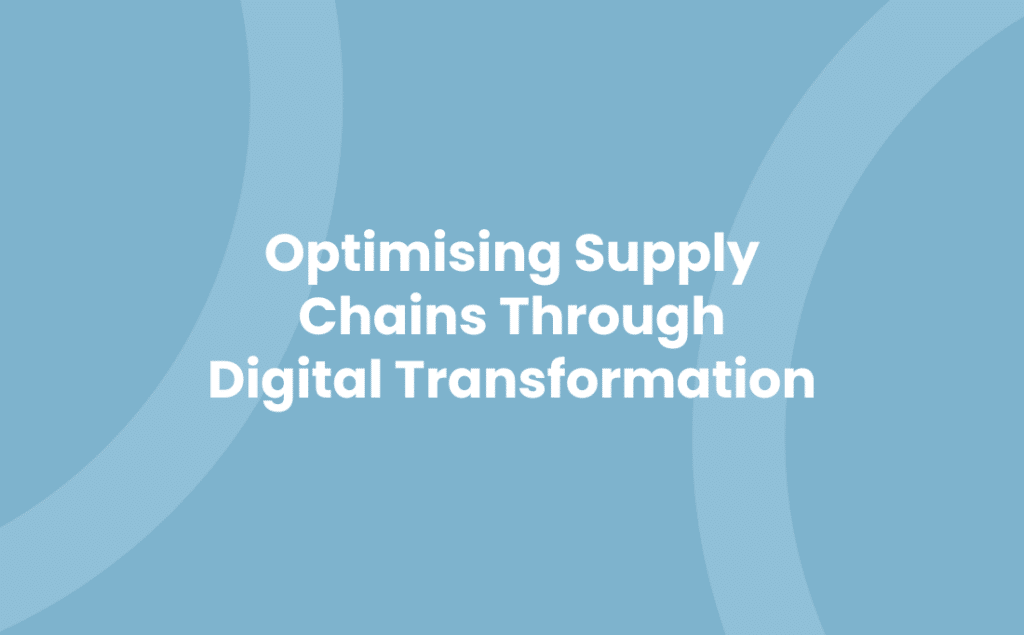Imagine a world where your supply chain operates like a well-oiled machine – efficient, seamless, and always a step ahead. That’s the promise of digital transformation in supply chain optimisation. In today’s fast-paced, digital-first world, it’s no longer a luxury but a necessity.
The march of technology isn’t slowing down, and neither should your business. Whether it’s predictive analytics forecasting demand or AI streamlining warehouse operations, digital transformation is revolutionising the way supply chains function.
Stay with us as we delve into the exciting world of digital transformation and supply chain optimisation. We’ll explore how you can leverage these technologies to stay competitive, improve efficiency, and drive growth. The future of supply chain is here, and it’s digital.
Understanding Digital Transformation
In your journey to greatness, digital transformation plays a crucial part, serving as a crucial catalyst in the world of supply chain optimisation. Your business taps into the power of technology, bringing about significant shifts in existing methods, boosting both efficiency and growth.
- Digital Enhancements: Let’s focus on advanced modifications that digital transformation brings into the supply chain. The inclusion of technologies like artificial intelligence and predictive analytics propels your overall operations to an entirely new dimension.
- Technological Insights: You’ll find that these cutting-edge technologies offer deep insights, enabling accurate demand forecasting and seamless warehouse management.
- Strategic Edge: Adopting such digital tools gives your business a strategic edge, enhancing your competitiveness in today’s digital landscape.
Digital transformation in the supply chain isn’t a mere adoption of technology; it’s a paradigm shift that remoulds traditional methods and pushes your business towards tides of innovation and advancement. As you navigate the digital tide, remember that your goal isn’t just adopting technology but optimising your entire operation, hence the term “digital supply optimisation”.
Intriguingly, the future of supply chains rests on digital transformation. By embracing this shift, your business will unlock new horizons of growth and efficiency. The ripple effect of this transformation is far-reaching, touching every aspect of your supply chain operations, from demand forecasting to delivery.
Finally, remember that understanding digital transformation is a crucial step in this journey. So, take time to delve deep into its implications in your industry, thoroughly exploring how it’s revolutionising the way you do business.
Realigning your business strategies with digital transformation, you’ll be equipping your enterprise with the right tools to thrive in the digital age. As a digitally transformed business, you’re not just surviving in your industry; you’re leading, teaching, and setting the pace for others to follow.
The Relation Between Digital Transformation and Supply Chain
The tide of digital change rides high, revolutionising supply chain operations. As observed, it’s not just about plugging into the newest technologies; it refers to a shift of epic proportions, one that redefines traditional methods and paves the way for innovation and expansion.
Integrating digital transformation supply chain strategies empowers businesses. Digital supply optimisation, for instance, opens innovative vistas for growth and efficiency. Your business isn’t simply adopting technology; it’s embracing a future designed for success.
Advancing your supply chain through digital transformation might seem complex, but it’s incredibly satisfying. Your business can leverage a vast array of technologies such as artificial intelligence and predictive analytics. These tools contribute to a more streamlined, efficient, and resilient supply chain.
There’s a deep connection between digital transformation and your supply chain. For example, with integrated digital strategies, your business can analyse and predict market trends, leading to improved inventory management. In addition, digital transformation can enhance transparency across the supply chain, improving accountability and trust.
In the new digital era, businesses are shifting from traditional methods. The optimal use of digital tools can reduce operational costs, increase speed and improve accuracy. These benefits, in turn, add value to your business and define a clear path for growth and efficiency in the new digital age.
With the acceleration of technological advancements, digital transformation will no doubt continue to redefine the connection with the supply chain. As a business, embracing this tide of change isn’t an option but a necessity. Embrace digital transformation, optimise your supply chain, and reap the competitive advantages of an efficient, future-proof business.
Insights into Digital Transformation Supply Chain Optimisation
Peering deeper into the sphere of digital transformation supply chain optimisation, it’s evident that rejuvenation isn’t only about integrating innovative technologies. The true essence underlining this process lies in reimagining your business model, augmenting it with digital tools and strategising for leverage in market trends.
Attuned digital strategies play a crucial role in improving inventory management. By harnessing advanced analytics, you can gain real-time insights into your inventory. Timely and accurate information permits predicative analysis, paving the way for proactive approach in chain optimisation. This approach asserts efficient utilisation, reducing waste and improving your bottom line.
Transparency is another valuable asset realised through digital transformation. Supply chains often suffer from opaque processes, leading to inefficiencies. By transitioning to digital platforms, transparency enhances regulatory compliance and also fosters a culture of accountability within the organisation.
Digital transformation with relevant and robust tools also facilitates better communication and collaboration among stakeholders. Integrated platforms break down silos, fostering collaboration. When teams share and access the same data, decision making speeds up. Quick, informed decisions mean businesses are agile in changing market scenarios.
Moreover, digital transformation doesn’t serve as the magic wand making challenges disappear overnight. Implementation can turn into a tricky matter if not handled expertly, considering the intricacies involved. However, once you’ve successfully navigated this avenue, the rewards overweigh the hurdles.
Digital transformation supply chain optimisation is hence more than a one-time project. It’s a gradual, constant process. The path to innovation is fraught with obstacles if not handled correctly, but with expert guidance and a firm commitment to change, your business can reap the benefits, sop up profits and thrive in the digital era. Remember, embracing such transformation is no longer luxury, but a necessary investment for securing future prosperity.
Current Trends in Digital Transformation Supply Chain Optimisation
Driving the wheels of change, certain trends in digital transformation supply chain optimisation stand out. Their influence on how businesses boost efficiency and stay competitive cannot be undermined.
- Real-Time Visibility
Companies are integrating technologies like IoT, AI, and blockchain into their operations. This integration grants visibility into every stage of the supply chain. Businesses gain the advantage of real-time tracking of products from manufacturing to delivery. - Predictive Analytics
Companies employ predictive analytics to navigate through an avalanche of data. This tool helps process past trends and current data, providing companies with insights about potential opportunities or pitfalls. - Automation
Automation is replacing manual processes in the supply chain. Robotic process automation (RPA) leads to faster, error-free processing and lowers operational costs. - Integration
Integration of systems in supply chain operations is on the rise. Seamless integration of systems such as supply chain management (SCM), customer relationship management (CRM), and enterprise resource planning (ERP) optimises processes and improves service delivery. - Sustainability
Amid growing environmental concerns, companies are turning to digital supply optimisation. This shift includes the use of renewable resources, waste reduction strategies, and eco-friendly packaging. - Risk Management
With globalisation and complexity of supply chains, risk management is crucial. Companies are leveraging technologies like AI and predictive analytics to anticipate and manage potential risks. - Collaboration
Collaboration within and across organisations is increasing. Companies are working together in various projects to meet common goals more efficiently.
These trends provide a directional compass, guiding businesses in the realms of digital transformation and supply optimisation. By embracing these trends, businesses can boost productivity, cut costs, and lead the digital revolution in supply chain operations. Means and methods may vary, yet one thing remains the same: staying ahead of trends is paramount to surviving in our digitally-driven, fast-paced economic climate.
Effective Strategies for Implementing Digital Transformation in the Supply Chain
For successful digital transformation supply chain activation, strategising serves as a pivotal step. It safeguards your business against the turbulences of the digital era, promoting overall success. Here, some reliable strategies are discussed.
Clearly Define Your Vision: Possessing a well-defined vision for your digital transformation can guide your efforts. For instance, with the clear aim of ‘improving real-time visibility’, you can streamline technology adoption accordingly.
Prioritise Technologies: Not every technology may serve your specific supply chain needs. Apply a selective approach and prioritise. For example, if your goals align more with efficiency, automation might be your path.
Develop an Adaptable IT Architecture: A flexible IT architecture allows seamless integration of new technologies. A well-designed framework can grow alongside technological advancements, promoting continuity in operations despite advancing digital trends.
Harness Data: Data forms the backbone of digital transformation. Ensuring adept usage of relevant analytic tools, one can uncover hidden patterns, predict market trends, and optimise operations at levels previously unimaginable.
Invest in Skilled Human Resources: While digital tools and processes are instrumental, they function optimally with skilled handling. Adequate training of your workforce in digital tools and practices boosts competence, leading to efficient management of digital strategies.
Partnership and Collaboration: Leveraging collaborative partnerships can provide access to new capabilities necessary for complex digital transformations. Partnering with tech firms, for instance, can pave the way for rapid, efficient digital supply optimisation.
Embrace Change Management: Change can be unnerving, yet is an inevitable part of digital transformation. Embracing change management helps you navigate this shift smoothly, ensuring your workforce is comfortable with new technologies and processes.
Sustainability Consideration: While evolving with digital trends, do not lose sight of sustainability. For a successful future, balance your digital transformations with considerations for environmental and social sustainability.
Implementing these strategies during your supply chain digital transformation can usher in efficiency and robustness. While each strategy carries its own weight, they collectively accelerate the journey of digital supply chain optimisation.
Case Studies of Successful Digital Transformation Supply Chain Optimisation
Several businesses have evidenced the power of digital transformation across their supply chain. These successes highlight both the strategies previously discussed and the importance of introducing digital technology to supply chain operations.
Firstly, the multinational healthcare company, Johnson & Johnson, stands as a prime example. They leveraged predictive analytics, a facet of digital transformation, to predict supply chain bottlenecks before they occurred. The impact was a reduction in inventory holding costs by 11% and an improvement in overall customer service.
Secondly, we turn our attention to Bosch. The global engineering and tech firm incorporated artificial intelligence in their production processes. The result has been a boost in demand forecast accuracy by 10%, driving profits and customer service ratings simultaneously.
Thirdly, let’s discuss Starbucks’ digital supply optimisation. Their application uses AI to predict customer preferences, enabling an efficient supply chain that can meet demands accurately. Consequently, Starbucks saw a revamp in their operational efficiency and customer satisfaction levels.
Lastly, consider Amazon’s amazing transformation. Embracing digital transformation from its inception, they’ve excelled in predictive supply chain modelling. Consequently, Amazon’s 225% increase in profits from 2010 – 2019 testifies to the benefits of a digital supply chain.
Each case provided underpins the gains and growth digital transformation can bring to a supply chain. Confidently diving into the realm of digitalisation in your own business, remember, these big names started as you are now. Success, efficiency, and innovation sit ready for harnessing in this ever-evolving world of digital supply chain optimisation.
Challenges and Solutions in Digital Transformation Supply Chain Optimisation
Undoubtedly, the shift towards digitalisation presents a host of challenges. Right from cultural overhaul, lack of digital literacy, to cybersecurity threats, there’s a wide gamut of hurdles.
However, do not fret. The key lies in turning these challenges into opportunities for growth and improvement.
Cultural Overhaul
In traditional supply chains, the workforce often resists digitisation. From manual data recording to paper invoices, there’s a comfort in sticking to the ‘tried and tested’. However, digital transformation necessitates a cultural change. Breaking through resistance, you would require company-wide efforts to foster openness and adaptability to new technologies. For instance, Amazon transformed its supply chain by initiating robust training programs, thereby fostering a culture shift towards embracing digital tools and processes.
Digital Illiteracy
Lack of digital skills among your workforce makes digital transformation daunting. Address this by investing in comprehensive training programs. Starbucks successfully tackled this by setting up training segments in their digital week initiative to quicken the adaption of new digital tools among staff.
Cybersecurity Threats
As you move towards a digitally optimised supply chain, cybersecurity issues become a prominent concern. Protect your systems from potential threats with rigorous cybersecurity measures like encrypted communications, secure user verifications, and constantly updated firewalls. Bosch’s use of state-of-the-art security services and solution packages can exemplify this tactic.
Integrating New Technologies with Existing Systems
The mixed bag of old and new technologies can be baffling. The amalgamation of digital tools with existing systems could become a nightmare if not properly managed. Ones that succeed, like Johnson & Johnson, do so by gradually integrating digital solutions into their existing supply chain processes.
Digital transformation supply chain challenges don’t have to be intimidating. By transforming these hurdles into stepping stones to improvement, you can accelerate your journey towards digital supply optimisation.
Conclusion
You’ve seen how digital transformation can revolutionise supply chain operations. The implementation of AI and predictive analytics isn’t just a trend; it’s a necessity for businesses striving for efficiency and profitability. You’ve learnt from industry giants like Amazon and Johnson & Johnson, witnessing the tangible benefits of embracing digital technologies. But remember, it’s not an easy road. Challenges like cultural resistance and cybersecurity threats are real, yet they’re opportunities for growth, not setbacks. Investing in a skilled workforce, fostering a culture shift, and taking a gradual approach to technology integration are keys to successful digital transformation. So, as you embark on your journey towards a digitally optimised supply chain, keep these insights in mind. The digital future awaits, and it’s yours to shape.



